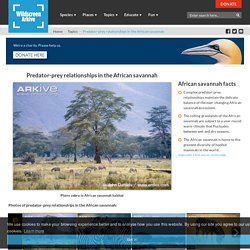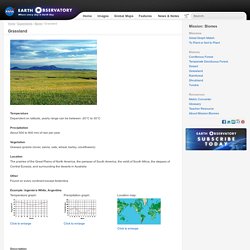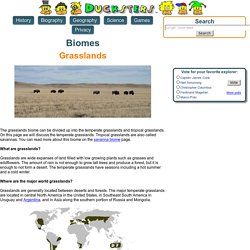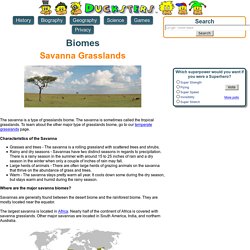

UK Grasslands. There is very little entirely natural grassland left in the UK and most of the grassland we are familiar with can be described as semi-natural, having been altered throughout history by farming practices such as grazing, mowing, burning and the removal of larger plants.

Throughout the UK there are a number of different types of grassland which vary depending on the soil type and geography of the area. Meadows Meadows are perhaps the best known of all grasslands, famous for their rich variety of wildflowers. There are various types of meadow found in the UK, from lowland meadows and flood pastures to the scarce upland hay meadows of the north of England. Meadows must be actively managed using traditional farming methods and after the flowers have seeded these grasslands are cut for hay and reverted to grazing during the winter. Predator-prey relationships in the African savannah. Explore the real science behind Team WILD’s mission to survey predator-prey relationships in the African savannah.

Why do Root and Flora, our Team WILD science superheroes, need help surveying predator-prey relationships in African savannah? All living things depend on each other for survival, and the relationship that exists between predators and their prey is a prime example of just how closely linked species are. Changes in the population size of one species can drastically affect that of another. This, in turn, has the potential to affect all other species within a particular ecosystem, either positively or negatively, shifting the delicate balance of species. The role that predators play in their environment actually helps to create and maintain greater diversity within an ecosystem, through regulating the abundance and distribution of prey species, providing vital food sources for scavengers, and removing sick, injured and weak individuals from prey populations.
Animals in the Savanna. African rock python African rock python The rock python is Africa’s biggest snake.

It can grow up to 7m (23ft) in length, and can easily kill and eat a gazelle. Pythons › Plains zebra Plains zebra These beautifully striped animals roam the savanna in groups, looking for fresh grass and water. Zebras › Giraffes Giraffes With their long necks and legs, giraffes are well-equipped to eat leaves from high tree branches. Giraffes › African elephants African elephants The largest living land animals, African elephants feed on a variety of plants. Elephants › Gazelles Gazelles Gazelles are fast and agile runners. Thomson’s gazelle › Cheetah Cheetah. Grassland - Reference. Grasslands (also known as prairies and savanna) are areas where the vegetation is dominated by grasses and other herbaceous (non-woody) plants.

Grasslands occur naturally on all continents except Antarctica and as flowering plants, grasses grow in great concentrations in climates where annual rainfall ranges between 500 and 900 mm. The grassland habitat is often greatly dependent on the region in which it is found, as grasslands differ from one another around the world.
In temperate areas, such as north-west Europe, grasslands are dominated by perennial (year-round) species, whereas in warmer climates it is the annual plant species that form a greater part of the vegetation. Grasslands are found in most climates but the grassland vegetation can vary in height from very short (less than 30cm (12in) high) to quite tall. Woody plants, shrubs or trees may occur on some grasslands - forming savanna, scrubby grassland or semi-wooded grassland, such as the vast African savanna plains. Enchanted Learning. National Geographic. Grasslands go by many names.

In the U.S. Midwest, they're known as prairies. In South America, they're called pampas. Central Eurasian grasslands are referred to as steppes, while in Africa they're named savannas. What they all have in common is grass as their naturally dominant vegetation. In fact, most grasslands are located between forests and deserts. There are two different kinds of grasslands: tropical and temperate. Tropical grasslands are warm year round, but usually have a dry and a rainy season. Temperate grasslands, which average between 10 and 30 inches (25 and 75 centimeters) of rain per year, have shorter grasses, sometimes just a few millimeters.
The animals that live in temperate grasslands have adapted to the dry, windy conditions. When rainy season arrives, many grasslands become coated with flowers, some of which can survive well into winter with the help of underground storage organs and thick stem bases. Earth Observatory. Temperature Dependent on latitude, yearly range can be between -20°C to 30°C Precipitation About 500 to 900 mm of rain per year Vegetation.

Grassland Facts. Science for Kids. The grasslands biome can be divided up into the temperate grasslands and tropical grasslands.

On this page we will discuss the temperate grasslands. Tropical grasslands are also called savannas. You can read more about this biome on the savanna biome page. Science for Kids. The savanna is a type of grasslands biome.

The savanna is sometimes called the tropical grasslands. To learn about the other major type of grasslands biome, go to our temperate grasslands page. Characteristics of the Savanna Grasses and trees - The savanna is a rolling grassland with scattered trees and shrubs. Rainy and dry seasons - Savannas have two distinct seasons in regards to precipitation. African Savanna.